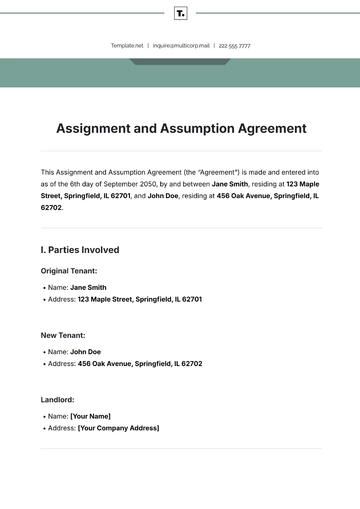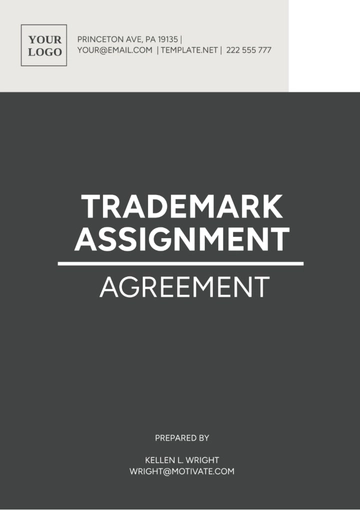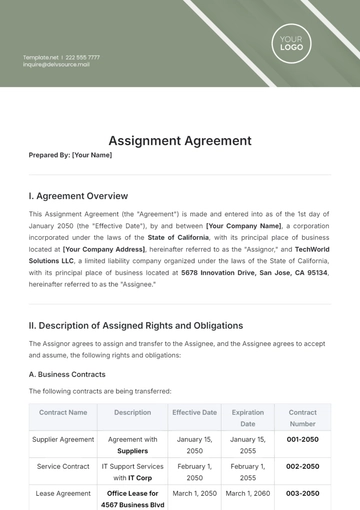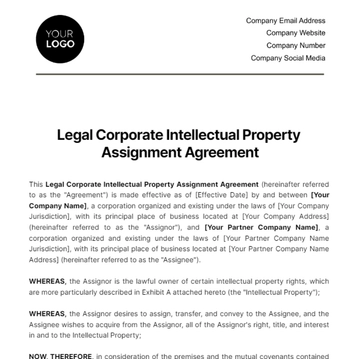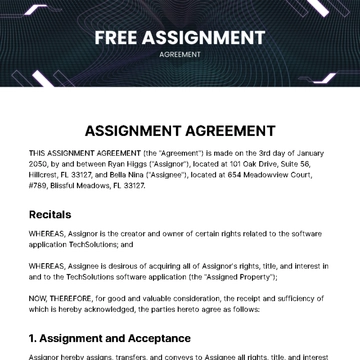Free Legal Corporate Intellectual Property Assignment Agreement
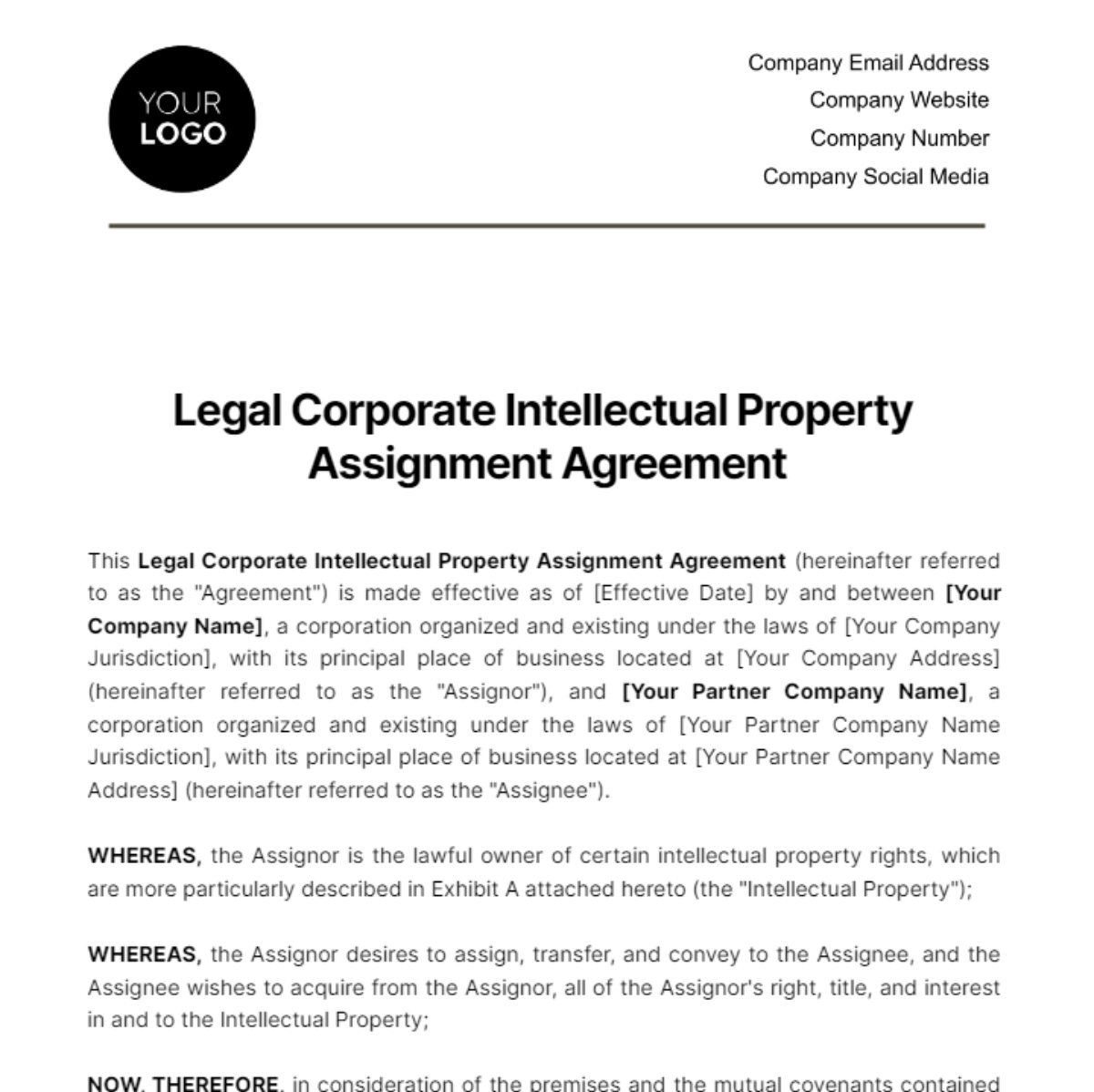
This Legal Corporate Intellectual Property Assignment Agreement (hereinafter referred to as the "Agreement") is made effective as of [Effective Date] by and between [Your Company Name], a corporation organized and existing under the laws of [Your Company Jurisdiction], with its principal place of business located at [Your Company Address] (hereinafter referred to as the "Assignor"), and [Your Partner Company Name], a corporation organized and existing under the laws of [Your Partner Company Name Jurisdiction], with its principal place of business located at [Your Partner Company Name Address] (hereinafter referred to as the "Assignee").
WHEREAS, the Assignor is the lawful owner of certain intellectual property rights, which are more particularly described in Exhibit A attached hereto (the "Intellectual Property");
WHEREAS, the Assignor desires to assign, transfer, and convey to the Assignee, and the Assignee wishes to acquire from the Assignor, all of the Assignor's right, title, and interest in and to the Intellectual Property;
NOW, THEREFORE, in consideration of the premises and the mutual covenants contained herein, and for other good and valuable consideration, the receipt and sufficiency of which are hereby acknowledged, the parties hereto agree as follows:
1. Assignment and Transfer
This clause forms the core of the Legal Corporate Intellectual Property Assignment Agreement. It signifies the complete transfer of all intellectual property rights from the Assignor to the Assignee. The terms under this section are explicitly outlined to ensure there is a clear and unequivocal transfer of rights, title, and interest in the intellectual property (IP) in question.
1.1. Rights, Title, and Interest
Rights: Refers to the legal entitlements associated with the intellectual property. This includes, but is not limited to, the right to reproduce the work, to prepare derivative works, to distribute copies, to perform the work publicly, and to display the work publicly.
Title: Implies ownership and includes all legal evidence of the Assignor's right to the intellectual property. It encompasses both registered and unregistered rights, whether obtained by statute, operation of law, or otherwise.
Interest: Covers any ancillary benefits, royalties, revenues, and other financial interests derived from the intellectual property.
1.2. Scope of Assignment
The assignment is absolute and without reservation, indicating that the Assignor relinquishes all claims to the intellectual property, including future rights and interests.
Territorial Extent: This agreement has a global reach, transferring rights in all countries and jurisdictions. This ensures that the Assignee acquires a unified and consistent set of rights worldwide, facilitating international commerce and protection of the intellectual property.
Effectiveness: The transfer of rights becomes legally binding upon the execution of this Agreement, solidifying the Assignee's ownership immediately.
1.3. Operational Implications
Upon transfer, the Assignee gains the exclusive right to use, license, sell, or otherwise dispose of the intellectual property as it sees fit. This includes the development, manufacture, marketing, and sale of products or services under the protected intellectual property.
The Assignor, from the moment of agreement execution, is precluded from exercising any of the rights previously held over the intellectual property. This includes ceasing any ongoing uses that infringe upon the newly established rights of the Assignee.
1.5. Documentation and Formalities
The Assignor is required to provide any necessary documentation that may be required to register or otherwise formalize the transfer of rights to the Assignee.
This can include assignments of patents, copyright registrations, trademark registrations, and any other documents necessary to effectuate the transfer in various jurisdictions.
The Assignor is also responsible for executing any further instruments that the Assignee reasonably deems necessary to perfect the Assignee's rights to the intellectual property.
2. Intellectual Property
This section delineates the scope of the intellectual property (IP) being transferred under the agreement. It is intentionally broad to encompass all forms of IP that the Assignor owns or controls, ensuring comprehensive coverage.
2.1. Categories of Intellectual Property
Patents: Legal protections granted for inventions, allowing the holder to exclude others from making, using, selling, or importing the patented invention without permission. This includes both utility patents for new processes and machines, and design patents for new, original, and ornamental designs for an article of manufacture.
Trademarks and Service Marks: Symbols, names, and slogans used to identify goods or services of a particular source and distinguish them from others. Trademarks are used for products, while service marks are used for services. This category also includes trade dress, which protects the visual appearance of a product or its packaging.
Trade Names: The names under which a business operates. Unlike trademarks, which identify goods or services, trade names identify companies or businesses.
Domain Names: The addresses used on the internet that correspond to the internet protocol resource of the business. Domain names are critical for businesses operating online, serving as a digital identity.
Copyrights: Rights granted to the creators of original works of authorship, including literary, dramatic, musical, artistic, and certain other intellectual works, both published and unpublished. Copyright protection exists from the moment the work is created and fixed in a tangible form that is perceivable either directly or with the aid of a machine or device.
Trade Secrets: Information, including a formula, pattern, compilation, program, device, method, technique, or process, that derives independent economic value from not being generally known to, and not being readily ascertainable by proper means by, other persons who can obtain economic value from its disclosure or use.
Know-How: Practical knowledge on how to accomplish something, such as manufacturing a product, which may not be confidential like trade secrets but is valuable for its practical application.
2.2. Scope and Jurisdiction
The definition explicitly states that the intellectual property subject to this agreement includes all such rights "that may exist now or subsequently come into existence." This forward-looking language ensures that future intellectual property rights, which the Assignor develops or acquires, are also included within the scope of this agreement.
The global scope of the rights, "under the laws of any state, country, or other jurisdiction worldwide," ensures that the assignment is comprehensive and not limited to the jurisdiction in which the Assignor is located. This is crucial for businesses operating in a global market, where intellectual property protection needs to be enforced across borders.
2.3. Operational Implications
Ownership or control by the Assignor is a key criterion. This clause makes it clear that the agreement covers all IP that the Assignor has the legal right to assign, regardless of whether it is fully owned or controlled under a license or other legal arrangement.
By including a broad range of intellectual property types and specifying that the agreement covers both existing and future rights, this clause ensures that the Assignee receives a complete transfer of IP rights. This allows the Assignee to fully exploit the intellectual property in its business operations, including development, manufacturing, and marketing efforts.
3. Warranties
The Assignor represents and warrants to the Assignee that:
The Assignor is the legal and beneficial owner of the entire right, title, and interest in and to the Intellectual Property and has the full right, power, and authority to enter into this Agreement and to assign the Intellectual Property as contemplated herein;
The Intellectual Property is free from all liens, encumbrances, and rights of others;
The Assignor has not previously assigned, transferred, licensed, or otherwise encumbered any rights in the Intellectual Property;
The use of the Intellectual Property by the Assignee does not and will not infringe the rights of any third party.
4. Indemnification
The Assignor shall indemnify, defend, and hold harmless the Assignee against any and all claims, losses, damages, liabilities, costs, and expenses (including reasonable attorney's fees) arising out of or in connection with any breach or alleged breach of any of the warranties, representations, and covenants made by the Assignor herein.
5. Governing Law and Jurisdiction
This Agreement shall be governed by and construed in accordance with the laws of [State/Country], without giving effect to any principles of conflicts of law. Any legal action or proceeding arising under this Agreement will be brought exclusively in the courts of [State/Country], and the parties hereby irrevocably consent to the personal jurisdiction and venue therein.
6. Miscellaneous
Amendments and Waivers. Any term of this Agreement may be amended or waived only with the written consent of the parties.
Entire Agreement. This Agreement constitutes the entire agreement between the parties with respect to the subject matter hereof and supersedes all prior or contemporaneous agreements, understandings, representations, or communications, whether written or oral.
Successors and Assigns. This Agreement shall be binding upon and inure to the benefit of the parties hereto and their respective successors and assigns.
IN WITNESS WHEREOF, the parties have executed this Legal Corporate Intellectual Property Assignment Agreement as of the date first above written.
[Your Signature]
[Your Name]
[Your Job Title]
[Your Company Name]
[Signature]
[Name of the representative of your partner company]
[Job Title of the representative of your partner company]
[Your Partner Company Name]
Exhibit A
Description of Intellectual Property
- 100% Customizable, free editor
- Access 1 Million+ Templates, photo’s & graphics
- Download or share as a template
- Click and replace photos, graphics, text, backgrounds
- Resize, crop, AI write & more
- Access advanced editor
This editable Legal Corporate Intellectual Property Assignment Agreement Template from Template.net is ideal for professionals requiring accessibility and customizability. Designed to simplify the intricate legal process, it's editable in our Ai Editor Tool for the perfect personalization. A game-changer for your marketing operations, this template assures accuracy while saving time, elevating your firm's professionalism and efficiency. Embrace this opportunity for expertly crafted, customizable legal solutions.
You may also like
- Lease Agreement
- Non Compete Agreement
- Rental Agreement
- Prenuptial Agreement
- Non Disclosure Agreement
- Operating Agreement
- Hold Harmless Agreement
- LLC Operating Agreement
- Arbitration Agreement
- Purchase Agreement
- Residential Lease Agreement
- Executive Agreement
- Confidentiality Agreement
- Contractor Agreement
- Partnership Agreement
- Postnuptial Agreement
- Collective Bargaining Agreement
- Loan Agreement
- Roommate Agreement
- Commercial Lease Agreement
- Separation Agreement
- Cohabitation Agreement
- Room Rental Agreement
- Child Custody Agreement
- Employee Agreement
- License Agreements
- Settlement Agreement
- Joint Venture Agreement
- Indemnity Agreement
- Subordination Agreement
- Sales Agreement
- Agreements Between Two Parties
- Business Agreement
- Real Estate Agreement
- HR Agreement
- Service Agreement
- Property Agreement
- Agreement Letter
- Restaurant Agreement
- Construction Agreement
- Finance Agreement
- Marketing Agreement
- Payment Agreement
- Investment Agreement
- Management Agreement
- Nonprofit Agreement
- Software Agreement
- Startup Agreement
- Agency Agreement
- Copyright Agreement
- Collaboration Agreement
- Reseller Agreement
- Car Rental Agreement
- Cleaning Services Agreement
- Consultant Agreement
- Deed Agreement
- Car Agreement
- Equipment Agreement
- Shares Agreement
- Data Sharing Agreement
- Advertising Agreement
- School Agreement
- Franchise Agreement
- Event Agreement
- Travel Agency Agreement
- Vehicle Agreement
- Board Resolution Agreement
- Land Agreement
- Binding Agreement
- Tenancy Agreement
- Exclusive Agreement
- Development Agreement
- Assignment Agreement
- Design Agreement
- Equity Agreement
- Mortgage Agreement
- Purchase and Sale Agreement
- Shareholder Agreement
- Vendor Agreement
- Royalty Agreement
- Vehicle Lease Agreement
- Hotel Agreement
- Tenant Agreement
- Artist Agreement
- Commission Agreement
- Consignment Agreement
- Debt Agreement
- Recruitment Agreement
- Training Agreement
- Transfer Agreement
- Apprenticeship Agreement
- IT and Software Agreement
- Referral Agreement
- Resolution Agreement
- Waiver Agreement
- Consent Agreement
- Partner Agreement
- Social Media Agreement
- Customer Agreement
- Credit Agreement
- Supply Agreement
- Agent Agreement
- Brand Agreement
- Law Firm Agreement
- Maintenance Agreement
- Mutual Agreement
- Retail Agreement
- Deposit Agreement
- Land Purchase Agreement
- Nursing Home Agreement
- Supplier Agreement
- Buy Sell Agreement
- Child Support Agreement
- Landlord Agreement
- Payment Plan Agreement
- Release Agreement
- Research Agreement
- Sponsorship Agreement
- Buyout Agreement
- Equipment Rental Agreement
- Farm Agreement
- Manufacturing Agreement
- Strategic Agreement
- Termination of Lease Agreement
- Compliance Agreement
- Family Agreement
- Interior Design Agreement
- Ownership Agreement
- Residential Lease Agreement
- Retainer Agreement
- Trade Agreement
- University Agreement
- Broker Agreement
- Dissolution Agreement
- Funding Agreement
- Hosting Agreement
- Investor Agreement
- Memorandum of Agreement
- Advisory Agreement
- Affiliate Agreement
- Freelancer Agreement
- Grant Agreement
- Master Service Agreement
- Parking Agreement
- Subscription Agreement
- Trust Agreement
- Cancellation Agreement
- Horse Agreement
- Influencer Agreement
- Membership Agreement
- Vacation Rental Agreement
- Wholesale Agreement
- Author Agreement
- Distributor Agreement
- Exchange Agreement
- Food Agreement
- Guarantee Agreement
- Installment Agreement
- Internship Agreement
- Music Agreement
- Severance Agreement
- Software Development Agreement
- Storage Agreement
- Facility Agreement
- Intercompany Agreement
- Lending Agreement
- Lodger Agreement
- Outsourcing Services Agreement
- Usage Agreement
- Assurance Agreement
- Photography Agreement
- Profit Sharing Agreement
- Relationship Agreement
- Rent To Own Agreement
- Repayment Agreement
- Volunteer Agreement
- Co Parenting Agreement
- HVAC Agreement
- Lawn Care Agreement
- SAAS Agreement
- Work from Home Agreement
- Coaching Agreement
- Protection Agreement
- Security Agreement
- Repair Agreement
- Agreements License
